As I sliced beets for borscht, Iris pointed out the familiar pattern hidden inside.
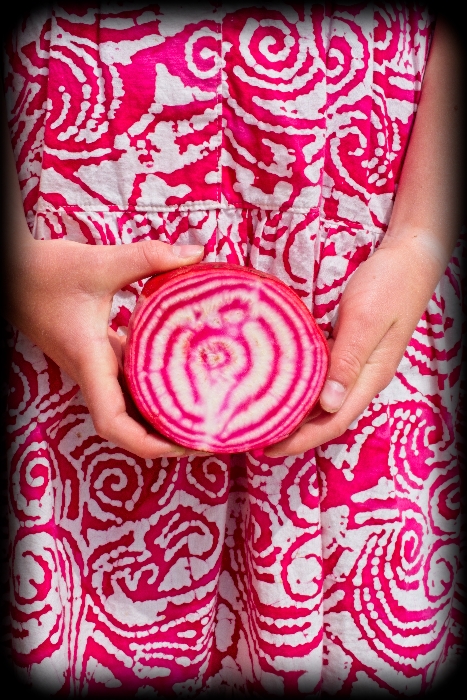
As I sliced beets for borscht, Iris pointed out the familiar pattern hidden inside.

This is Hymie. Hymie is nearly four, which is young for a doll, but he has had a rough life. He spent two years in a bed that was right next to a very large window with direct southern sun. The sun shone through the window on him all day. The fabric on his body and clothing (and the fabric on the bed linens) faded immensely and began to break down. I have never seen such rapid fabric breakdown! The part of Hymie that was under his clothing stayed in good condition, but his clothing went from a deep, rich green to an old, faded green. The nose, always a tender spot, got a small hole made worse by intense rubbing.

At my Akiva’s school, in kindergarten, they have a doll-party day each March. Hymie is really quite shy. He does not want to go, especially in such an embarrassing condition. Akiva said that he would rather borrow a strange doll than bring Hymie! I had promised to re-do Hymie by Akiva’s birthday, but will not have my son borrowing a strange doll for the party. Hymie will have new skin within the week.
I wanted to make Iris a new dress. First I picked a fabric from my stash. Hmm. Yellow with green leaves. Three yards. That should be good. Then I picked an idea. I wanted to make a new version of a dress I made two years ago. Seeing as Iris was playing happily, in lieu of measuring anything (my first mistake), I decided just to go maybe two sizes up, lengthen the bodice a bit, and make the skirt a bit longer.
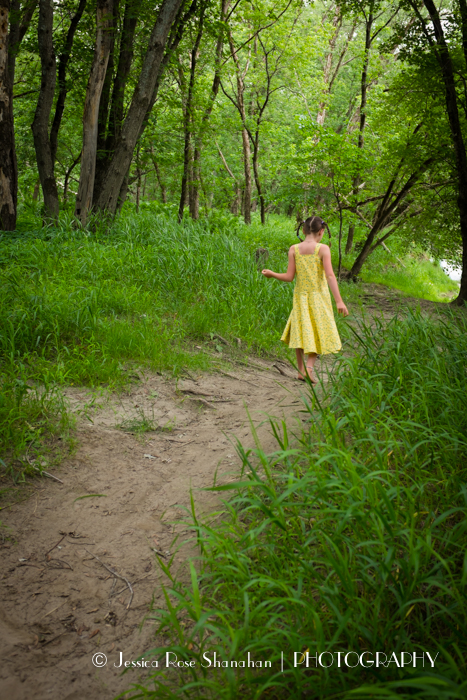
I made the bodice first. Lovely. Then I made the skirt. Oops. Not enough fabric. Fortunately, I’m great at piecing & I was able to piece together the circle skirt in a rather unusual, unnoticeable manner. I didn’t have any scraps large enough to cut pockets, so I cut them from a plain yellow, seeing as they would not be seen. Only the smallest, most useless scraps of fabric were left over.

I placed the pockets without measuring how long Iris’s arms are. I knew logically they should go at the top of the skirt, but I didn’t know if my circle skirt would exactly match the bodice, in terms of circumference. I wanted to leave room for possible miscalculation. My method for calculating the opening for the circle skirt is to do a bunch of math and then decrease the opening by one centimeter. I don’t know what the centimeter does, but last time, I wish I decreased the opening by one centimeter. I figured I’d better put the pockets too low instead of too high. If I put them too high, they might get cut in half if the diameter of the circle skirt is too small in diameter for the bodice due to my random one centimeter alteration. So I put them on the skirt, about three inches from the top. Things I do in a calculated manner I do in centimeters; things I do haphazardly I do in inches.
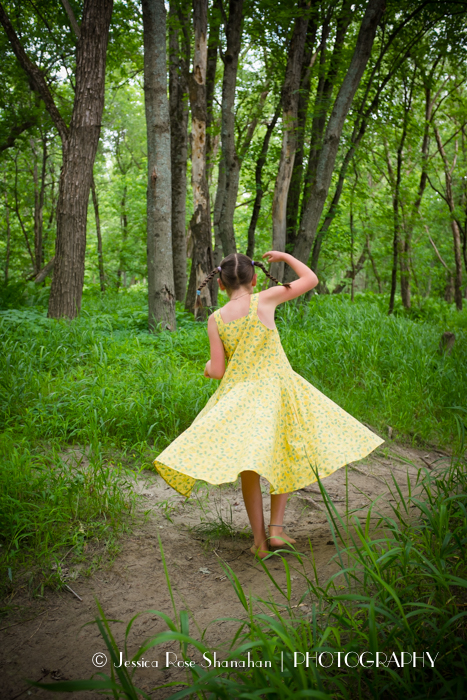
I used the rolled-hem foot for the first time on the bottom of the circle skirt. It turned out perfect, thank you. Then I attached the bodice to the skirt. That was also perfect! Thus, my random pocket placement is about 2.5 inches too low. Ugh. Useless! Finally, I went through the button box. I absconded with approximately 15,429 buttons from my mother’s house, so I always have the perfect button for every occasion*. In this case, I chose a pair of matching carved vintage mother-of-pearl buttons. Magnificent! I will not allow her to wear the dress anywhere.

For a photo shoot, we went to our new favorite spot on the Massawippi River. I discovered it one day when our old favorite spot had been just been shat upon. The shitter was still there. His shit was covered in flies and surrounded by toilet paper. He had shat right in the middle of the trail. Disgusting! I could tell it was him. He had stayed there a while, unpacked all his bike bags, eaten, and pooped in the middle of the trail. We biked up past him, right to the spot he used for a toilet, and he quickly got packing and left. Disgusting. So we had to leave, too, seeing as the spot was now ruined. The new favorite spot is lovely, tho.

I really don’t know what kind of occasion this dress is good for. Although I generally just let her wear the dresses I make anywhere, this one is a bit much and a bit more easily stained, due to its color, than the others. I suppose she can wear it to school, should school start up again in the spring. It should fit her for a couple of years. We will see if she still likes circle skirts and mama dresses when she is ten.
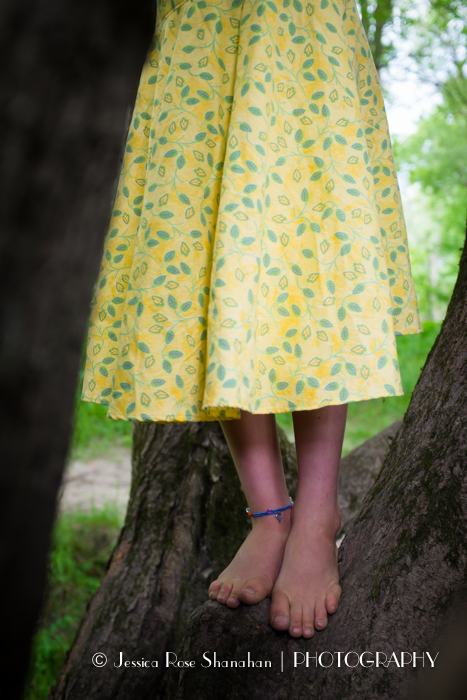
*NOTE: My mother does not have the perfect button for any occasion. In fact, she is no longer an owner-of-buttons. Sorry, Mom. I took them while you were plastering the ceiling. I thought you wouldn’t notice.**
**NOTE: Actually, Mom, you gave them to me saying that you probably wouldn’t use them any time soon. You would have been right had it not been for the completely unforeseeable global pandemic. The simple precaution of leaving you six plain buttons to make straps on which to hook your ear elastics to would certainly have prevented the pandemic in the same manner that carrying an umbrella keeps away the rain and that hanging the laundry is sure to induce a downpour. What I mean to say is, thank you for the buttons.
I finished a new doll.
Iris said, “You used to take pictures of me holding dolls.”
And so I did, again. This one will be going to France.
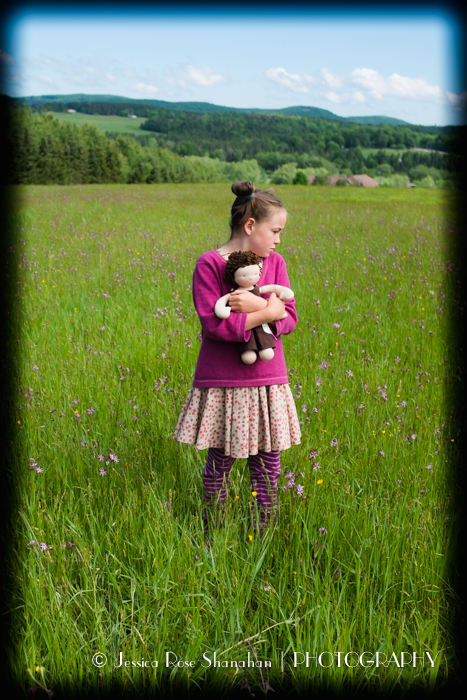
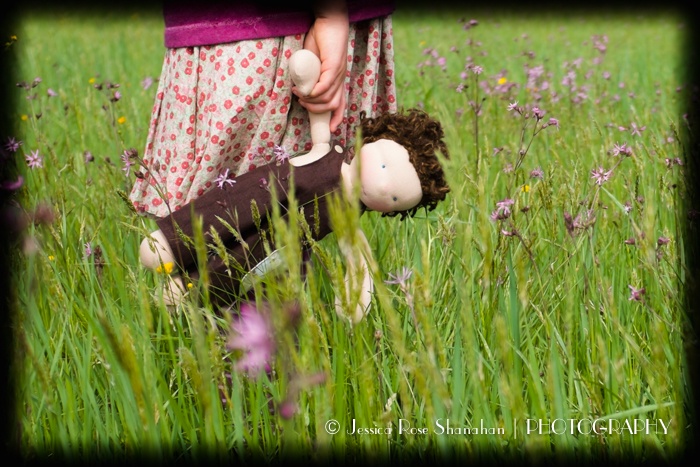


I applied to be a pattern tester for the small, indie pattern company “Twig + Tale.” I thought it would be fun! It wasn’t bad, but I did feel slightly taken advantage of.
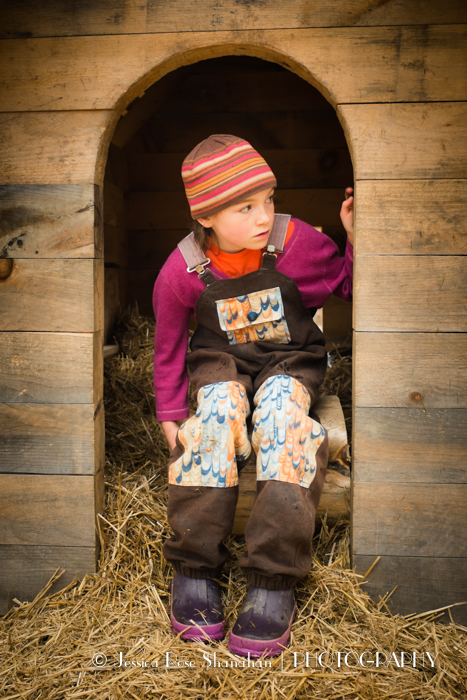
The pattern I tested was “Rain Overalls.” I was in the 3rd & final round of testing. I made a pair in canvas, then I waxed them. The good thing about being in the final round is that, by this time, the pattern really ought to work & you’re not just sewing up something that you probably won’t be wearing. They probably chose me for the finals because I can take nice photos. They want nice photos so that they can sell their product. That’s their m.o.
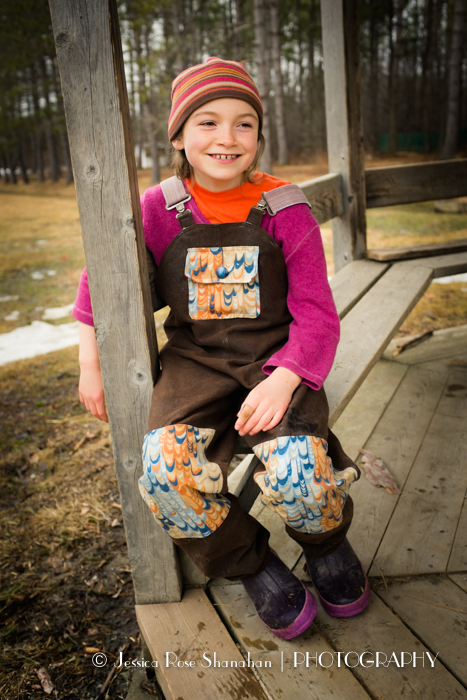
The bad thing about being a pattern tester is that you can’t get a dozen or so opinions of other people who have made the pattern & get some ideas as to what to do differently. This pattern, like most patterns, is far from perfect.

For one, there’s the straps. I knew that right away. Instead of making totally elastic straps, I used elastic for only part of the strap. I copied the format on my old Carhartts, where they used a small bit of elastic on the front of the straps. I also took the buckle off my old Carhartts. If I’d had some future-sight, I’d have put a mere two inches of elastic at the back of the overalls & made the rest of the straps from canvas.

Next, there’s the lining. I don’t have any photos of the lining. The lining is huge and horrid. Who would ever design overalls with such a huge and horrid lining? Ugh. It would be better to put bias tape on the inside of the coveralls. Or just a teeny lining. I hate the lining. Iris hates the lining. I’d cut it out, but I haven’t gotten the nerve yet. Everything is finished so perfectly that I don’t want raw edges on the inside of the garment. But there’s nothing else that could be done about the lining at this point! I’ve sewn it in & double top-stitched it and waxed it. The only way to get rid of it would be to cut it out. I know: a person wouldn’t notice from the outside. I would know!

Then there’s the elasticized cuffs. After breaking a bodkin, a safety pin, and an elastic puller, Martin invented a tool for me to insert the elastic into the cuffs. It was a sort of a spring & a sort of a wire. I think he said it was part of a plumbing implement. And this is why I love Martin! He may not be certain why on earth I’m doing what I’m doing and why I spend so much money on my hobbies, but he’s always willing to invent something useful to help me out.
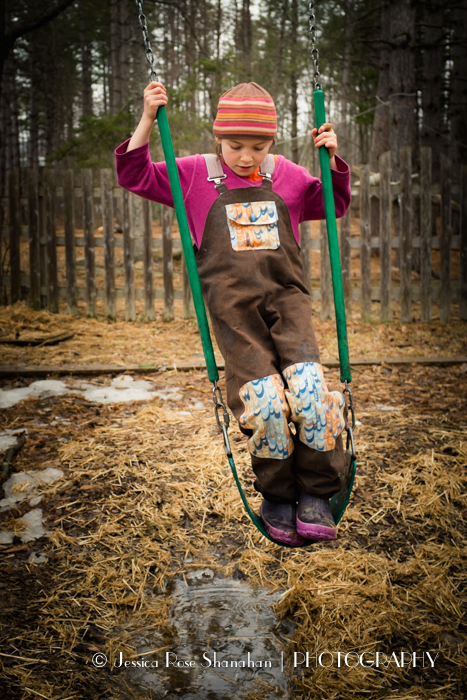
The final bad thing about being a pattern tester is deadlines. Sew the pattern by this date. Submit photos by this date. What? I had one week to sew and photograph these coveralls! All the stores were closed due to COVID. I happened to own the materials (brown canvas, a sample of cotton-linen fabric to use on the knee patches & kangaroo pocket), but I ran out of brown thread. I met a friend in the middle of the field, by moonlight, to receive some white elastic, which I proceeded to dye brownish. I had to cut the buckles off an old pair of my own coveralls, as I was incapable of buying anything. And, oh, school’s out, take care of the kids and do everything else you always do. What do you get for it? The pattern you already sewed! Humph.
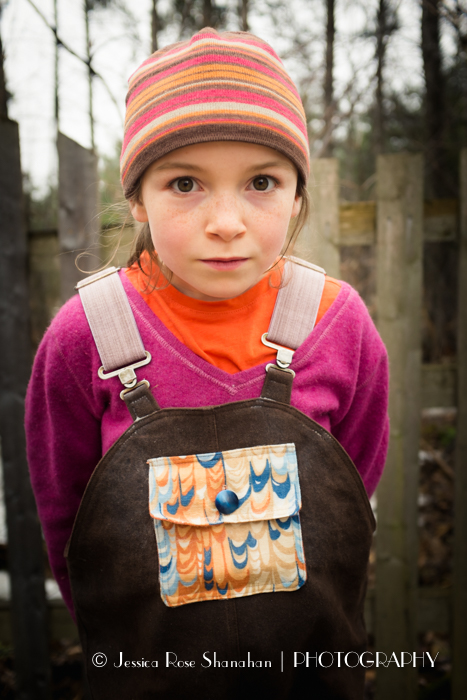
I realize that the pattern makers did not have waxed canvas in mind when making the pattern. However, Twig + Tale is a pattern company that encourages the use of natural fibers and upcycled materials for consumers sewing their patterns. For this reason, they must have been able to foresee that some loony mama was going to sew her kiddo a pair of waxed canvas rain coveralls. Waxed canvas is heavy. Waxed canvas is sticky. A pattern made for waxed canvas would generally be amenable to synthetic, light-weight waterproof fabrics, but a pattern made for synthetic, light-weight waterproof fabrics does not necessarily work well at all in waxed canvas. Because of the mission of Twig + Tale, I expected more from them. Alas! Alack! Such is the life of a sewer (ˈsō-ər).
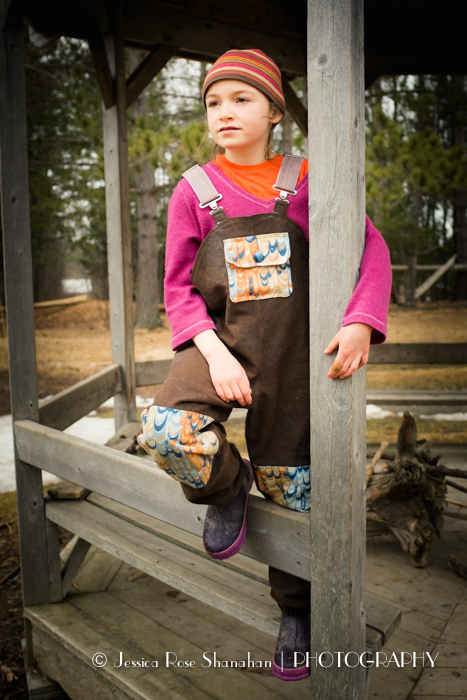
Anyhow. I had a good excuse to insist Iris do some modeling work for me. She’s good! Plus I got to use a beautiful glass button from the Magical Button Box. Thanks, Mom!

I don’t make many dolls anymore. Despite this, I got the itch to make a new style of doll dress. The pattern company Oliver + S has a cute little dress pattern for 18-inch dolls called “The Tea Party Doll Dress.” My dolls are neither 18 inches nor do they have the proportions of an 18-inch doll, but the style is adorable! I decided to alter the pattern to fit my dolls.
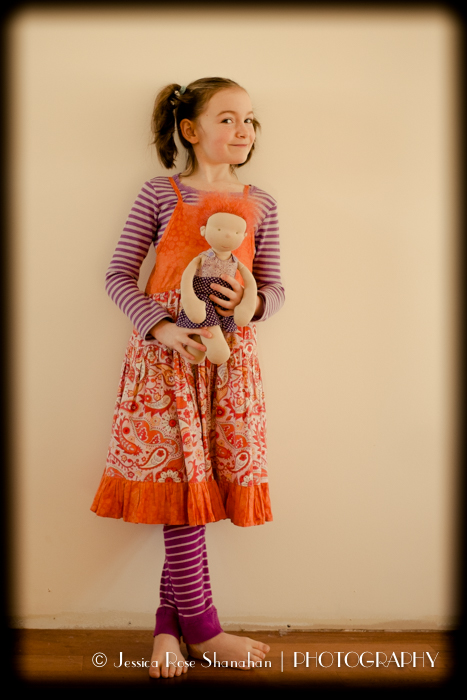
The problem with my dolls is that, unlike a factory-produced doll, they are all a bit different. I therefore have to make a dress for the largest potential doll I might make using my current pattern & let it have more wiggle-room on the smaller dolls. To alter the pattern correctly, I used my favorite method: trial & error.
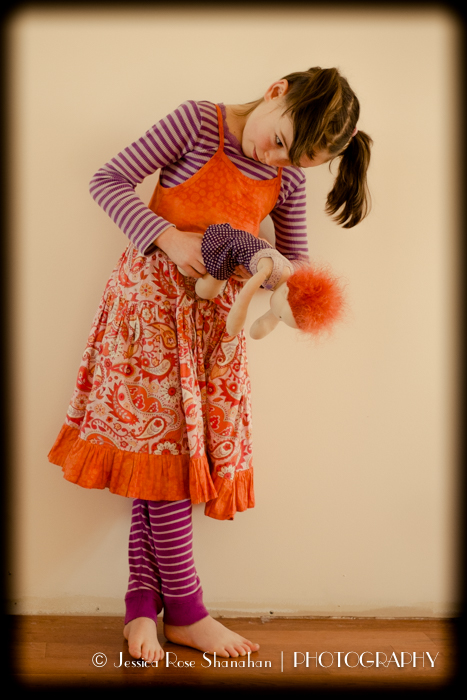
The first dress I made, using the very last scraps of some lovely polka-dot fabric and a few tiny scraps of batik, turned out to be to small for any of my current, chubbier dolls, but it fits Iris’s doll Peggy quite nicely. Peggy is a beloved doll with a shock of orange hair. She accompanied Iris through the trauma of kindergarten and will forever be the doll I hold closest to my heart.
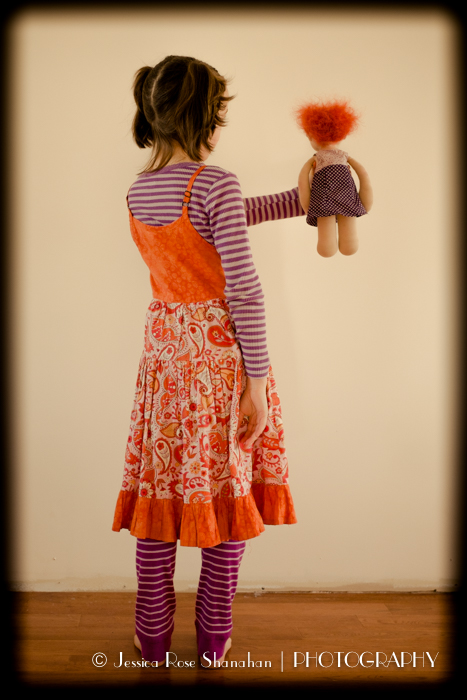
The second dress I made uses the very last scraps of an aqua batik that I used on a dress I designed for Iris, plus some scraps of an orange batik that I found in my large bin of tiny batik scraps. It fits my current, more full-bodied dolls quite well.
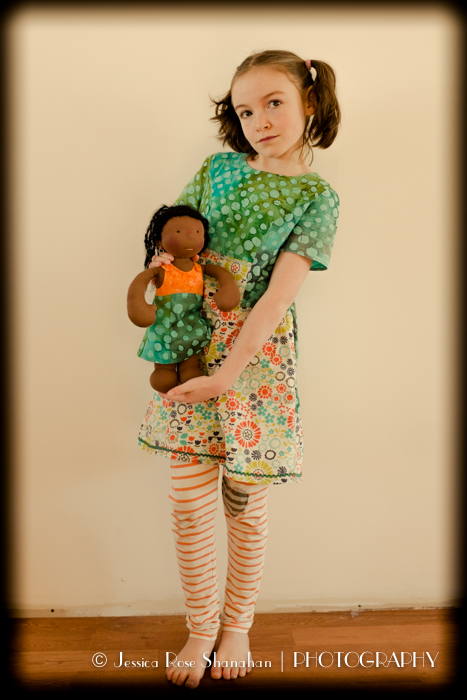
After a few weeks of agonizing over design and fabrics, sewing into the wee hours of the night, and ignoring my children in the name of entertaining them (don’t ponder the conflict of interest: art should not be reasoned out too much), I ended up with two lovely little dresses.
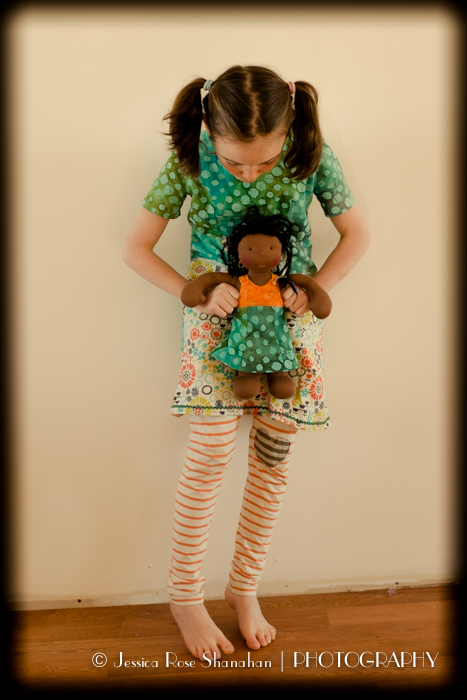
Most likely, I will never make this dress again. The true art is in the design. Production is mere craft.

Akiva was jealous that I was taking a lot of photos of Iris. Here’s one of you, too, Akiva!
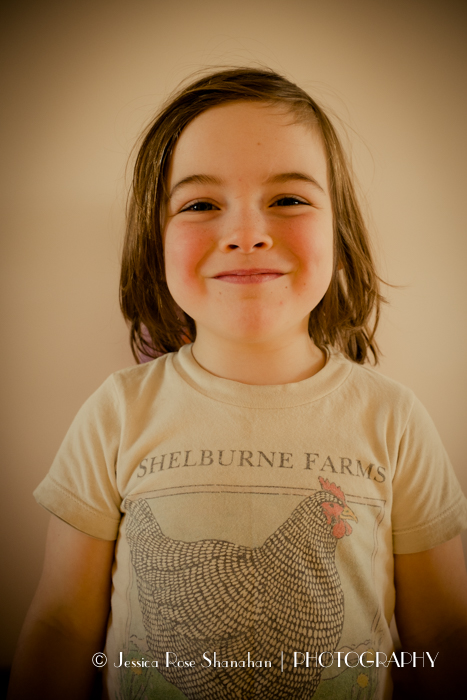
I love making dolls. I especially love making dolls for people who I get to meet.
Those are the most special dolls.
This doll is for an autistic boy who lives less than a mile from our house.
Iris likes to give each doll I make a squeeze and play with it for just a bit before it goes home.
If I am still making dolls far into the future, I will miss this part.
I will miss this part so much.
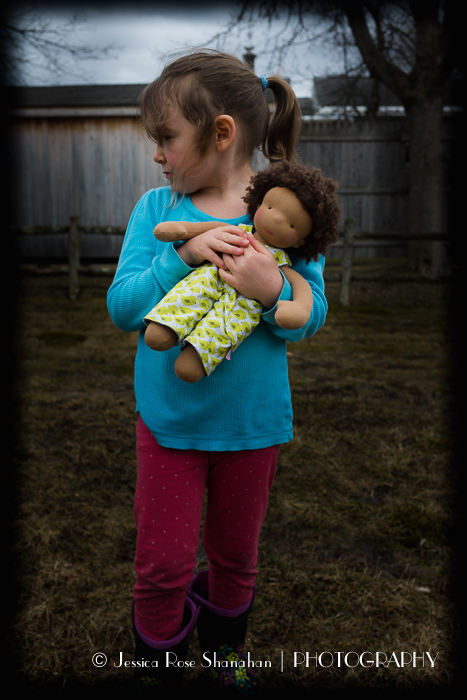
Iris says she only let me take her photo because I was really just taking photos of the doll.
The sun was in her eyes.
It was cold.
It is not very interesting to just stand there and look at a camera.
I didn’t want her to just stand there and look at the camera.
I wanted her to keep the doll off the muddy lawn
and to make it look even cuter than cute.
Iris is, by far, the cutest little girl I’ve ever made.
The dolls are getting consistently cute, too.
This one would be perfect, only her body is on backwards.
Tho you wouldn’t have known if I didn’t tell you 😉
Dying is fun!
I like when the yarn has variation to it.
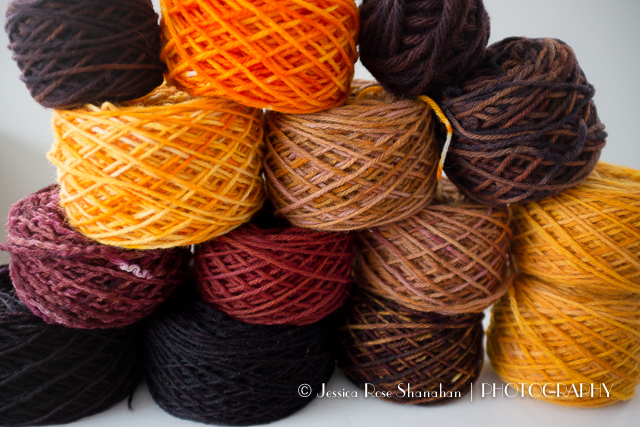
“How to niddy-noddy,” says Iris, taking apart the device and putting it together.
“How to niddy-noddy,” and I don’t know whether it is a question or a statement.
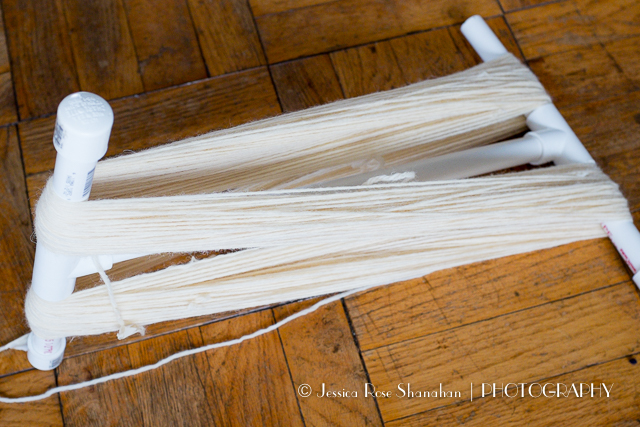
My previous dye technique involved putting yarn in a pot, dying it,
then spending an extraordinary amount of time untying tangles.
So I* made a niddy-noddy for looping nice hanks.
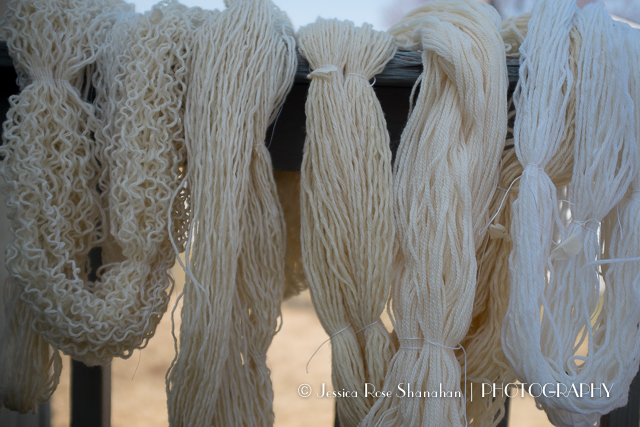
Nice hanks!
*NOTE: Martin made the niddy-noddy. I told him where to cut the PVC & after he cut it he accidentally put it together. It took all of three seconds. But I took it apart & put it together, so I made it, too. Then I suppose because Iris took it apart & put it together, she made it, too.